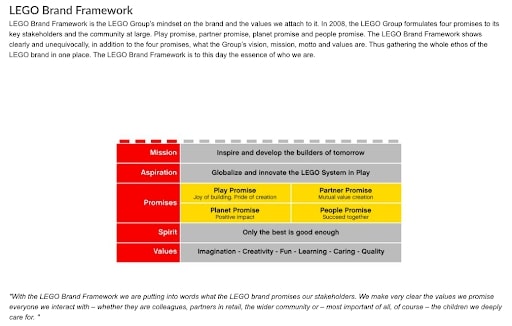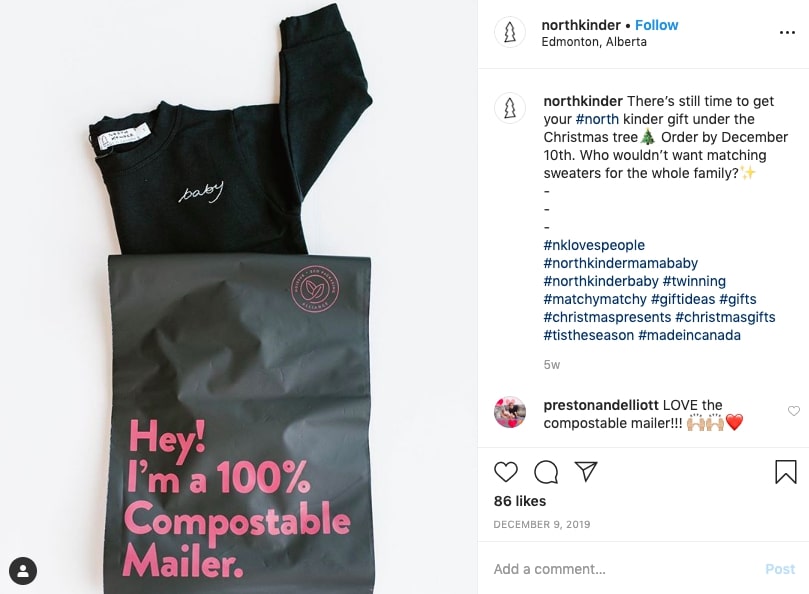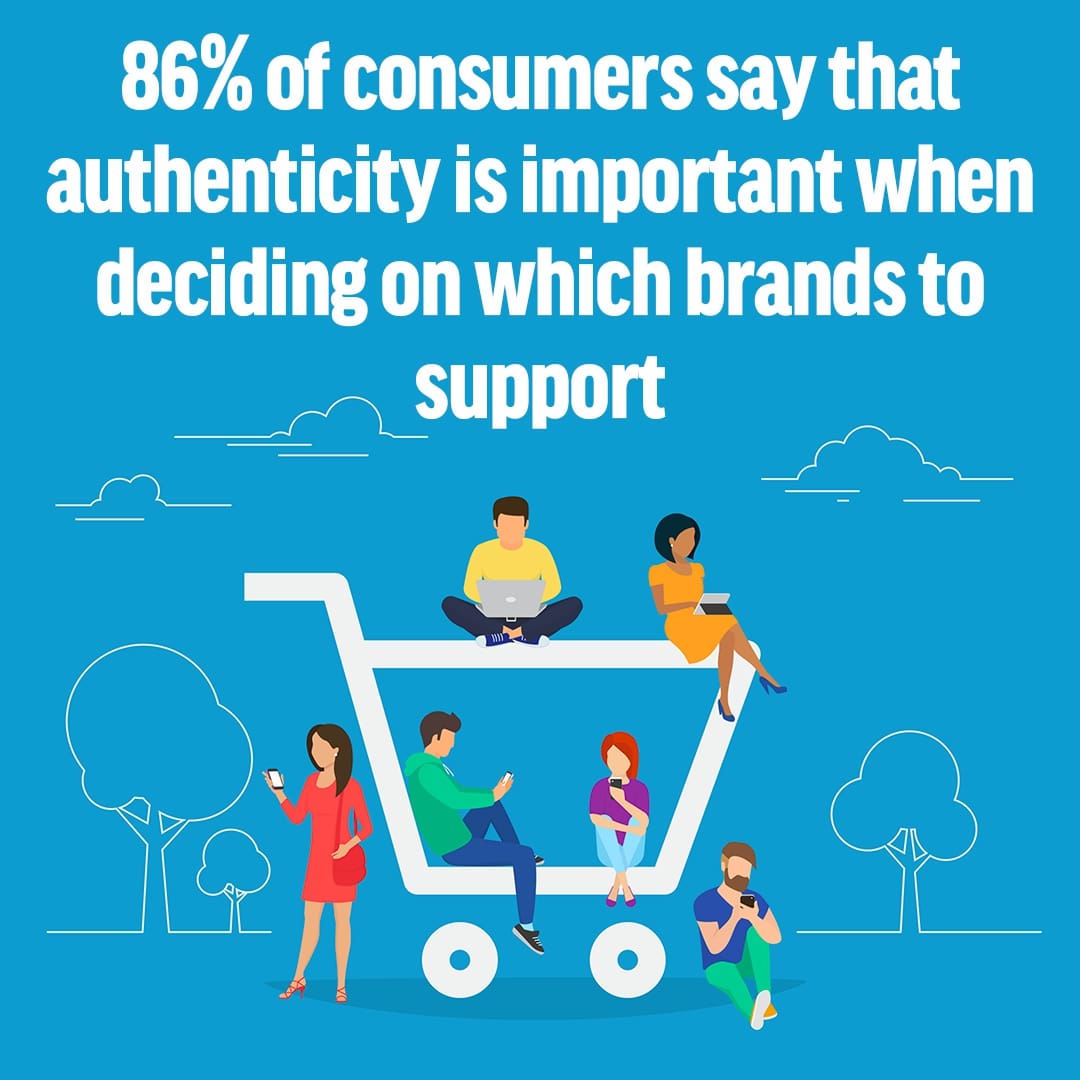Imagine that you’re scrolling through your Instagram feed and you come across a photo from a brand you follow.
You take a closer look, and can’t help but feel drawn to the authenticity of the post. The imagery feels genuine, and the post’s caption is written in “no-BS” language that cuts through the noise.
Now, let’s say you keep scrolling and see a post form a different brand. But unlike the previous photo, this one feels staged. The model looks too perfect and the copy is way too sales-y.
If you had to decide which company to support, which one would you choose?
If you’re like most people, you’d pick the first brand. Research shows that the majority of consumers — 86% to be exact — value authenticity when deciding on what companies to support.

The numbers are even more pronounced among younger consumers; 90% of Millennials put a lot of value on authenticity.
This goes to show that businesses that want to stay competitive in the coming years should be able to forge genuine connections and relationships with their customers.
In other words: you need to be authentic.
Let’s explore some of the ways that you can do just that.
1. Start By Getting Clear With What You Stand For
Authenticity is all about being true to yourself. It entails aligning your outward efforts (e.g., marketing, products, etc.) with your internal values. So, it stands to reason that being authentic starts with identifying those values.
How do you accomplish that?
Corrie LoGiudice, a strategist, author and speaker, says that when she works with clients on their authenticity strategy, she starts with getting clear on their brand’s purpose.
“The quickest way we bring out their authenticity in their marketing is by clarifying their business mission and what specific points they believe their customers need to know to be successful,” she explains.
“When someone is looking to hire a service or buy a product, it’s important to them that you believe what they believe. Which is why authenticity is so important,” Corrie adds.
Before you whip up fancy marketing campaigns, take the time to surface your mission, purpose, and values. This will allow you to get clear on what you stand for, which will then lead to more authentic marketing messages.
One brand that does this well is LEGO. To make sure that everyone knows what the company is all about, it formulated LEGO Brand Framework, a model that outline’s LEGO’s promises to its stakeholders and the community at large.
According to the company:
The LEGO Brand Framework shows clearly and unequivocally, in addition to the four promises, what the Group’s vision, mission, motto and values are. Thus gathering the whole ethos of the LEGO brand in one place.

See if you can do something similar in your business. Create a framework that concretizes your mission, vision, and values, then distribute it to your employees and stakeholders. Aside from clarifying your brand ethos, having a visual framework keeps your company accountable, helping to ensure that you live up to your promises.
2. Hire Individuals Who Naturally Embody Your Brand
Your employees — particularly those who are in customer-facing roles — play a big role in marketing your products and shaping the perception people have about your business.
That’s why it’s essential to bring in team members who naturally embody your band. Choose to hire people who share your values and are a good fit for your culture. Doing so not only makes staff training much easier, but your customers will likely feel a more genuine connection with your team, and in turn, your company.
Trader Joe’s (TJ’s) is one of the best examples of a company that makes hiring a key component of its branding strategy.
As a brand that’s known for being friendly, fearless, and even a little quirky, TJ’s lives up to that image is by hiring individuals who are naturally outgoing.
What’s more, Trader Joe’s gives employees the freedom to be themselves, as long as they keep customers happy. As one crew member told Business Insider:
“There’s no script… As long as I make sure the customer is having a great time, and I’m emphasizing Trader Joe’s values, I can talk to people about whatever I want.”
Because of this, TJ’s employees never have to fake it when interacting with shoppers. They can be themselves on the sales floor, and that authenticity effortlessly shines through.

3. Be Open About Your Ups and Downs
Honesty and transparency are the pillars of authenticity. If you want to forge genuine relationships with your audience, you need to be open to sharing your thoughts, stories, and even your struggles.
Having a “picture perfect” persona simply isn’t appealing as it used to be. Modern consumers are becoming increasingly cognizant of how false or misleading social media content can be, which is why it’s refreshing to see brands get real with their fans and followers.
Need inspiration on how to do this? Take a look at the streetwear brand Madhappy. Noah Raf, the company’s founder, is forthcoming about his struggles with mental health and has appeared in numerous panels discussing the issue.
Noah ensures that his company actively promotes mental health awareness by constantly publishing content on the topic, donating to the mental health organizations, and by giving people an avenue through which to share their own stories.
Here’s a look at Madhappy’s blog, which has an entire section dedicated to mental health:

Speaking to L’OFFICEL, Noah shares that part of Madhappy’s mission is to end the stigma around the issue. But he’s also upfront about the fact that they haven’t figured out everything yet.
According to him:
“I believe the real mission of Madhappy is to end the stigma around mental health and the thought that talking about our suffering means weakness. In doing that, we strive to help make the world a more optimistic place. We are still learning and figuring out all the steps that we can take in accomplishing that.”
That level of candor makes Noah, and as an extension, the Madhappy brand, much more relatable and helps the company create a stronger connection with consumers.
4. Show Off the Behind-the-scenes Action in Your Business
Another way to be more transparent? Pull back the curtain on your operations. Show your customers how you run your business and how your products are sourced or made.
Not only is this a great initiative in transparency and authenticity, but it’s an excellent way to market and sell your products. Behind-the-scenes efforts can build intrigue and excitement and around your brand and merchandise, which can ultimately drive sales.
The clothing company Reformation did an excellent job at this when it gave its Instagram followers a peek at its LA factory. What’s cool about the effort was Reformation didn’t just take photos or videos of its operation, but it also invited people to submit questions.
Check out Reformation’s stories below:

5. Show Off Your Personality
In a crowded marketplace filled with interchangeable brands and commoditized products, the best way to stand out is to let your true personality shine through.
Go back to your values, identify your brand’s distinctive characteristics, and make sure that they translate into everything you do — including your marketing copy and your product packaging.
Bubbsi, a skincare brand for babies and kids offers a great example of a company that does a great job in conveying its unique personality.
Bubbsi is all about “bringing giggles back to the baby aisle.” While many skincare brands have gotten too serious, Bubbsi stands out by incorporating a playful (but credible) voice into its initiatives. And that voice is consistent across the company’s website, ads, social accounts, and even its packaging.
Bubbsi has a gorgeous package that uses a minimalist but fun design. Bubbsi also throws in cards with sweet messages like “hey there bub” and “can’t way to snuggle ya.”

6. Be Real with Your Imagery
People can see through ultra-polished posts and airbrushed photos. And while these images technically look good, they’re not exactly relatable and they can come off as inauthentic.
There’s nothing wrong with enhancing images to make them look better, as long as you don’t overdo your photo retouching. You want to avoid setting unrealistic expectations, particularly when it comes to attractiveness and body image.
The good news is, businesses are increasingly recognizing the value of authentic imagery and are taking steps to make it happen. Aerie, for example, stopped retouching models in its photos and has committed to being real in its campaigns.

7. Get Personal With Your Audience
People want to buy and interface with other people, not faceless companies. That’s why it’s important to show off the wonderful humans who make your company tick.
If you’re the founder of the business or a senior member of the company, try putting in some facetime with your customers by interacting with them online or in-store. You might even consider sharing personal events or anecdotes. Taking this step helps humanize your brand, and builds stronger connections with customers.
Rebecca Minkoff does this well. Despite having a huge company, Rebecca makes it a point to get in front of the camera to talk to her audience and show off her company’s products. And she’s not afraid to share personal stuff either.
Here’s a story from Rebecca Minkoff announcing the birth of her son, Nicolai Valentine:

8. Leverage User-generated Content (UGC)
One of the best ways to implement authenticity marketing is to let your customers do it for you.
As Austin Shong, the digital marketing manager at Blip Billboards puts it, “You can’t get any more authentic than content produced by actual customers. No one can accuse you of being something you aren’t because it’s coming straight from the consumers’ peers.”
The skincare brand Curology puts user-generated content to good use by regularly featuring its customers in its Instagram feed. The company lets users do the talking by using their own words and photos in the posts.

9. Practice What You Preach
Last but certainly not least is to recognize that authenticity isn’t just about telling people how “real” you are… it’s about showing them.
You can preach about your values all you want, but if you’re not putting them into practice then you’ll come off as inauthentic.
See to it that your company is truly walking the talk when it comes to your brand’s mission and purpose.
If you’re all about women’s empowerment, for example, then you can put that into practice by having females in key leadership roles and by implementing women-friendly labor practices.
Or, if your company claims to care about the environment, see to it that you have eco-friendly practices in place.
North Kinder, a brand that stands for modern and ethical fashion, totally walks the talk when it comes to executing its mission. North Kinder’s products are locally designed in Edmonton, manufactured in Vancouver, and are sourced from soft bamboo fabric that’s comfortable and eco-friendly.
Speaking of which, North Kinder also implements eco-friendly packaging by using 100% compostable mailers.

Authenticity shouldn’t be viewed as a mere trend — it’s a way of life.
If you made it this far, then you’re likely brimming with ideas on how to incorporate authenticity in your marketing.
At the end of the day though, being real shouldn’t be a trend or tactic — it’s something that you should just do. There are certainly ways to amplify your brand’s voice and values, but putting too much effort into authenticity defeats the purpose.
The bottom line?
Know who you are. Get clear on your purpose. Then, show off your real self to the world.
Liked this? Click here to read the first in our 2020 eCommerce marketing trends series!

